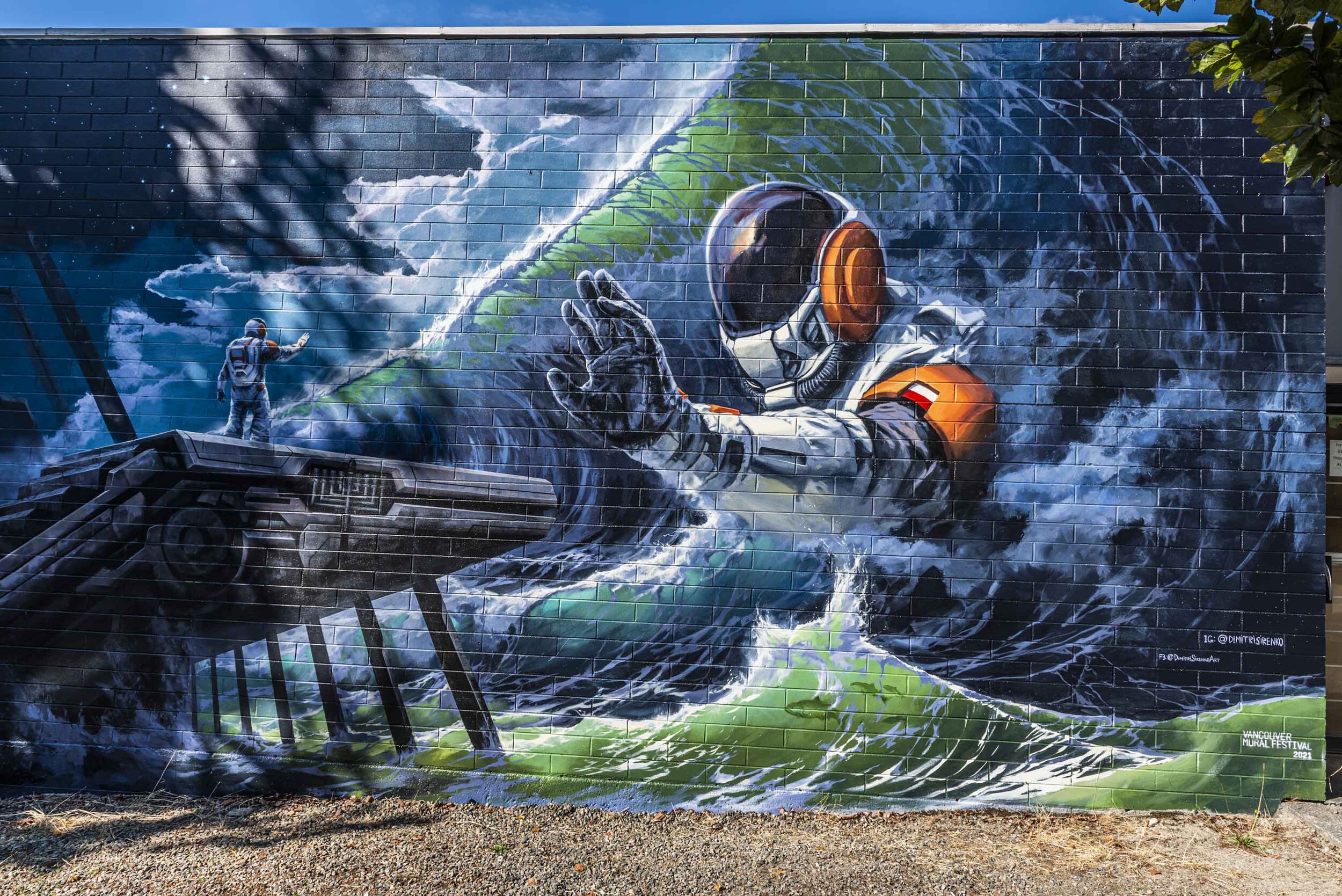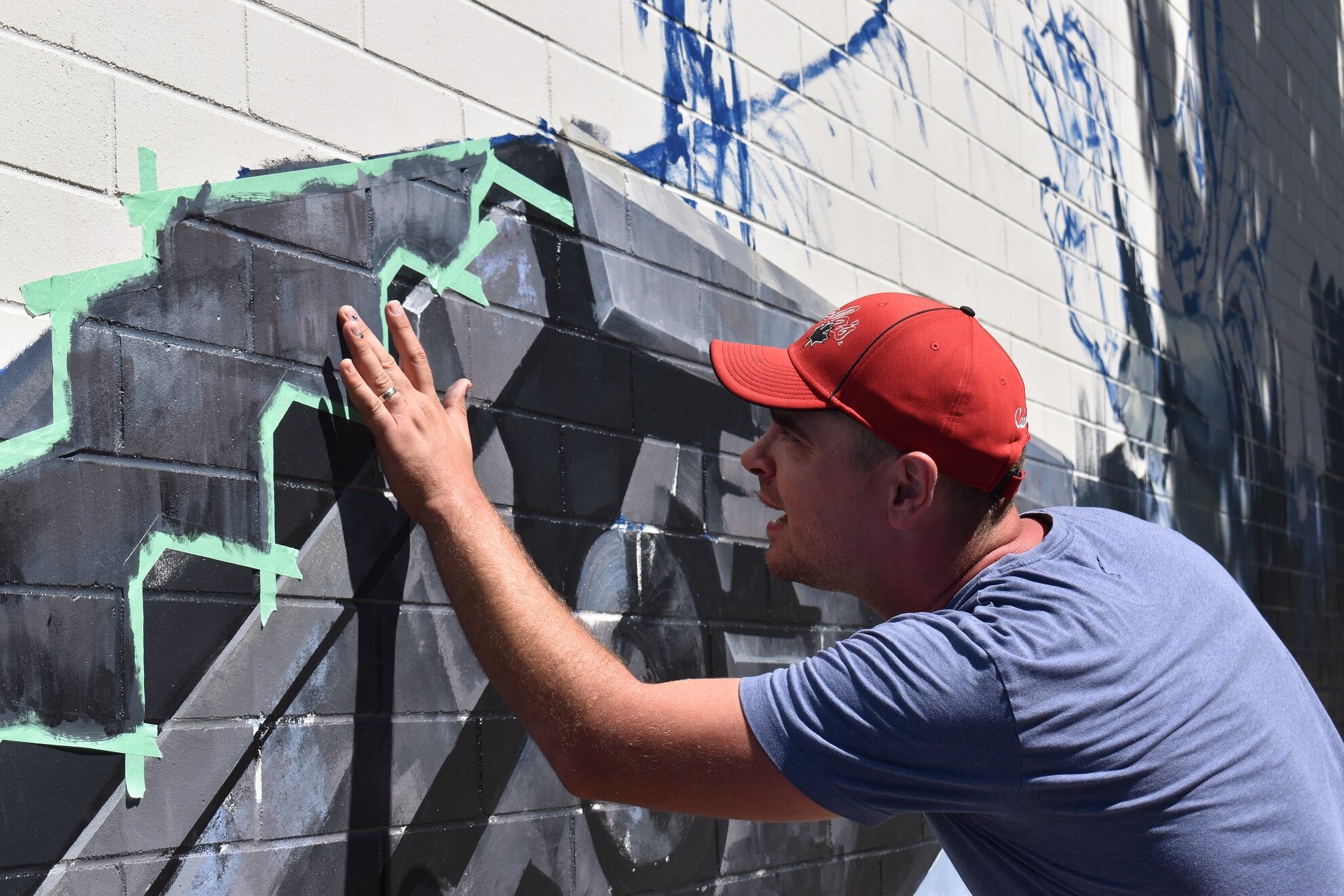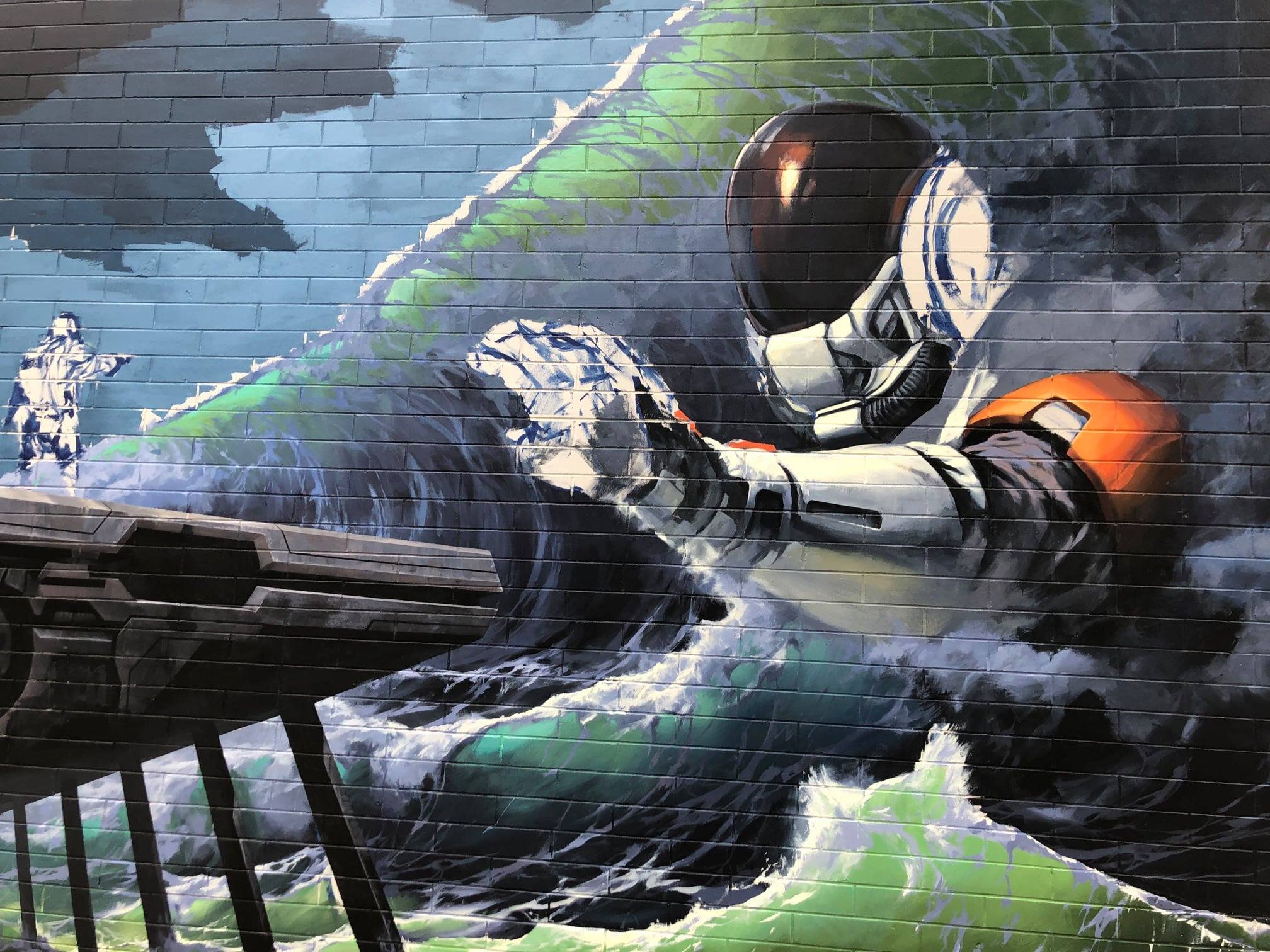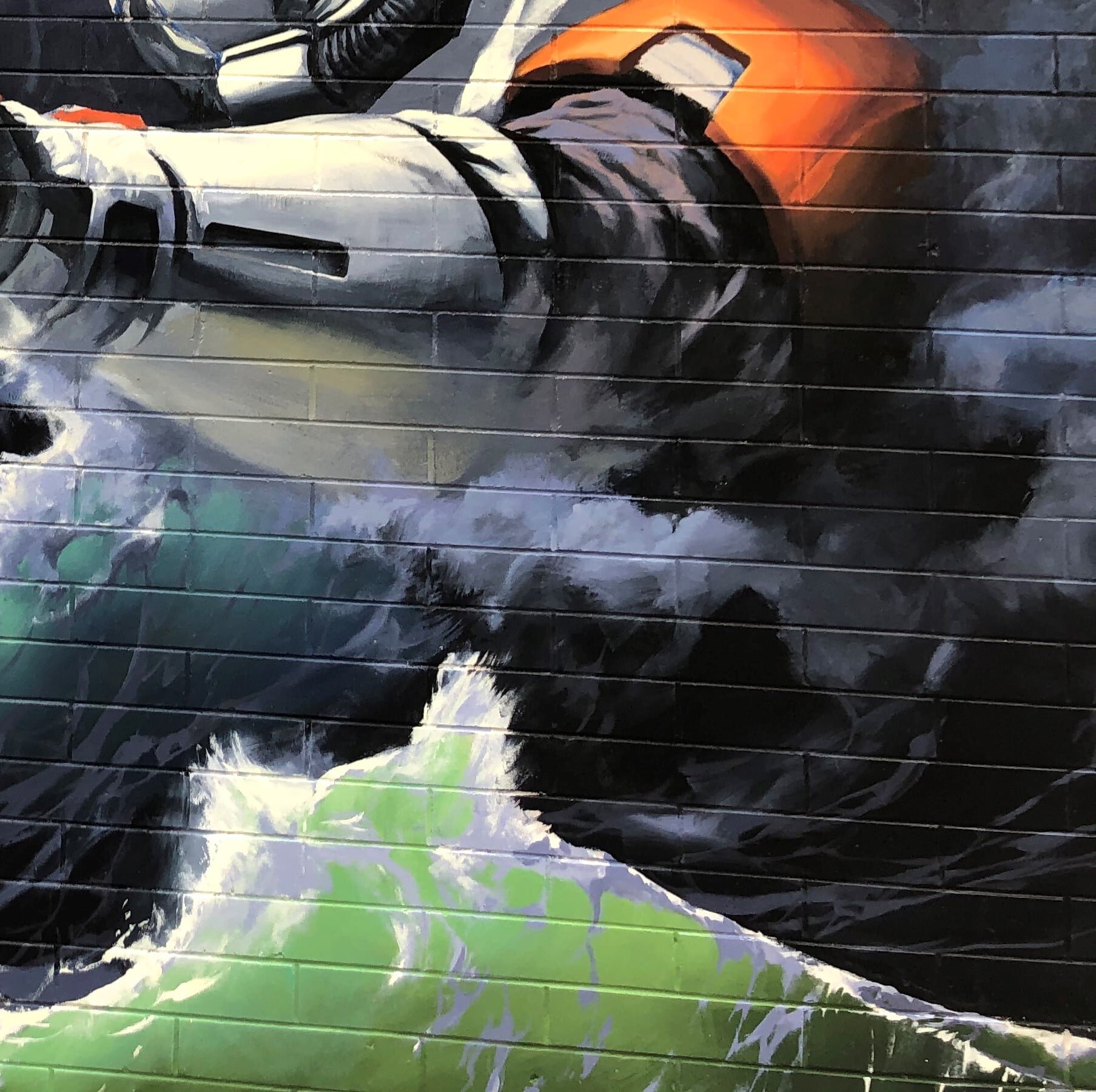Mural Commissioned by Polish Consulate Celebrates 100th Anniversary of Polish Author Stanisław Lem
Mural by Dimitri Sirenko
This year, the Vancouver Mural Festival is partnering with the Consulate General of the Republic of Poland to paint a mural in honour of the famed Polish author Stanisław Lem. As this August mark’s his 100th birthday, it is the perfect time to reflect on the writer and philosopher’s profound impact throughout Poland and the rest of the world – specifically in the science fiction realm. On Tuesday, August 17th at 2PM, we invite everyone to view and celebrate the mural at 61 East 5th Avenue in Vancouver.
The mural, titled Reflection, is being painted by Dimitri Sirenko, a Ukranian born Canadian artist. This is his first ever time painting a mural, and we are delighted to have him as a participating artist in this year’s festival. Dimitri developed his formal artistic background at Emily Carr University of Art and Design, majoring in design. After pursuing a career in animation/video game art direction, Dimitri began to switch his focus to more traditional artforms, developing a love for painting.
We had the opportunity to talk to Dimitri to discuss the mural and the complex and symbolic meanings it carries.
VMF: Can you tell us a little bit about yourself, your background and how it connects you to this mural?
DS: “I’m originally from the Ukraine, and immigrated here with my parents – I’ve always been into art and painting in general. But when I moved here, traditionally, obviously there is a whole stigma around being an artist and being a starving artist. So, opportunities presented themselves for me to go into media arts such as animation and video games. So that’s where I ended up going and doing full time for 11 years or so, and my goal during that time was to become an Art Director, to have more freedom of artistic expression and overall creativity, but the problem was when I finally got that I realized that working for someone else can never offer you that freedom…I did everything digitally as the industry would require and so I think it was that kind of, missing that creative freedom and not being fully satisfied with my job that made me look into traditional art after [11] years, and I began to lean into that… One of the biggest catalysts in that was Art Battle. One day I decided to go there and check it out, and I was like ‘hey I kind of feel inspired, I want to participate in this’ and so I did and I ended up winning a whole bunch of events, and actually winning the national championship of Canada in Toronto in 2018. So that in itself kind of gave me a good amount of confidence to keep doing it, and a lot of inspiration. And then the opportunity presented itself to try doing fine art full time when I had some troubles at my current job at that time. So, I left the job and I decided to do it full time… and it actually just took off and I became a full time fine artist. I’ve been painting ever since.”
VMF: So this is your first mural that you’re painting!
DS: “Yes, so it’s really exciting and also a little bit daunting because I don’t know all the technical aspects of which materials to use exactly etc, so you know it’s a great learning experience for me. I’m not unfamiliar with painting on a large scale, but I just haven’t painted on a wall before – so this will be a challenging experience but I wanna give it my best, my 120% just to make sure the message and the artwork is conveyed the way that I envision it.”
“I’m kind of relating [the mural] to the idea that the subtleties are the most important part of a human being, it’s kind of what defines us and teaches us along the way and what shapes our perception.”
-Dimitri Sirenko
VMF: Did you know who Lem was before you painted a piece that celebrates him and his work?
DS: “So that’s the interesting part too, I didn’t really know his name, I was kind of vaguely familiar with one of his most famous works called Solaris mainly because there were movies made based on that novel. But yeah, so far it’s been a really interesting experience, even just kind of researching and finding out what this author was about… he was a science fiction writer, but at the same time he was very unique and different from what science fiction would be defined as in western culture because he was trying to look at philosophical concepts behind science fiction, so it wasn’t really so much about commercial value for him, in terms of how fantastical it can get.. It was more about exploring human nature and exploring certain ideas and even criticizing certain ways that we as humans are.”
VMF: How has he influenced Polish culture?
DS: “So that was another interesting part too because I was like ‘okay, I’m not Polish…’ but yet [the Polish Consulate] was pretty interested in me taking on this project, and then when I had a talk with Andrzej [from the Consulate] and researched on my own and I realized it is really relatable because first of all Ukrainian culture is pretty close to Polish culture and secondly, Lem was actually born in the Ukraine and then he lived in Poland most of his life, so it’s kind of an interesting thing there, where it is relatable to me in some ways.”
“One of the best rewards of being an artist are the things that you learn along the way – whenever you take on your next project it’s up to you how far you want to go into the research and where you want to take it”
-Dimitri Sirenko
VMF: Why do you think the Polish Consulate chose Lem?
DS: “Well first of all it is the hundred year anniversary for him. Secondly, he is one of the few writers from Poland that was able to get a certain global recognition… out of many authors and writers of Poland he is definitely a national treasure because he was able to reach an interesting height in his career and [also had] a very unique approach to the genre that he was working within… One of the best rewards of being an artist are the things that you learn along the way – whenever you take on your next project it’s up to you how far you want to go into the research and where you want to take it, but that’s one of the really fun and informative processes – is actually researching about the subject and how to convey something that will do it justice.”
VMF: The mural has visual tie ins of First Nations, Isreali, and Ukrainian culture. Can you tell us a little bit about the different aspects of the mural that illustrate this?
DS: The way I approached it in terms of how I could relate Polish symbols into this one picture is not only to relate to Lem’s life, because there is hidden symbolism like [his] Jewish descent, and there is also a Polish flag hidden. All these things, I’m kind of relating it to the idea that the subtleties are the most important part of a human being, it’s kind of what defines us and teaches us along the way and what shapes our perception; and then as artists or creative people we can communicate that through our mediums. But at the same time it’s also very related to one of Lem’s [concepts, where] instead of looking out in the skies and searching for this other civilization, we should probably focus on ourselves. He believed that what we are looking for is a reflection of ourselves, so he would say we need a mirror instead of going out in space and looking for something else. I find that very interesting, because it speaks to so many ideas…looking inwards is more difficult because it is more subtle – so all these symbols that we put into this artwork, I feel like they kind of reflect that idea of the subtleties that we never really notice and pay attention to. Only things that we can sense with our primary sensory organs. So that’s kind of how I related all of those symbols within the artwork, and of course there is a little bit of symbolism in terms of the First Nations and [being on] their land. Just very subtle, it’s not something that sticks out right in your face, but that is kind of the idea there.
This mural dedicated to Lem is the first major cultural project related to Poland carried out with the participation of the Polish institutions in Vancouver since the start of COVID-19. The previous project was the staging of the opera “The Passenger” by Mieczysław Wajnberg in January and February 2020.
Find this mural and 300+ more with the VMF Mobile App





